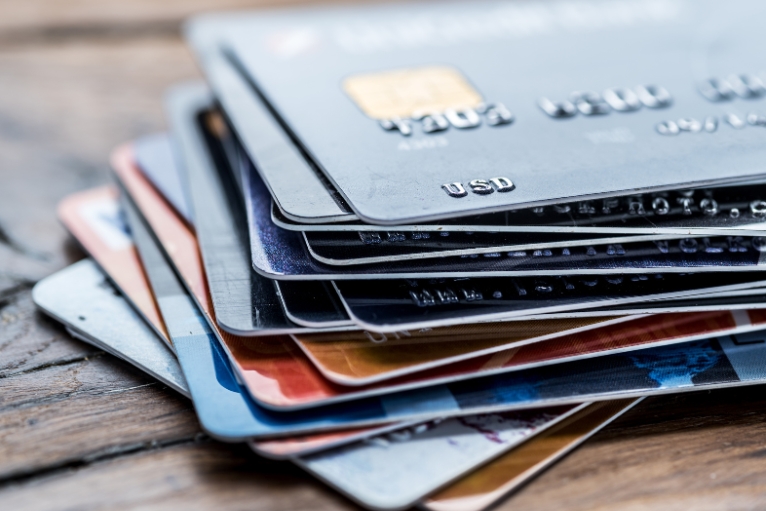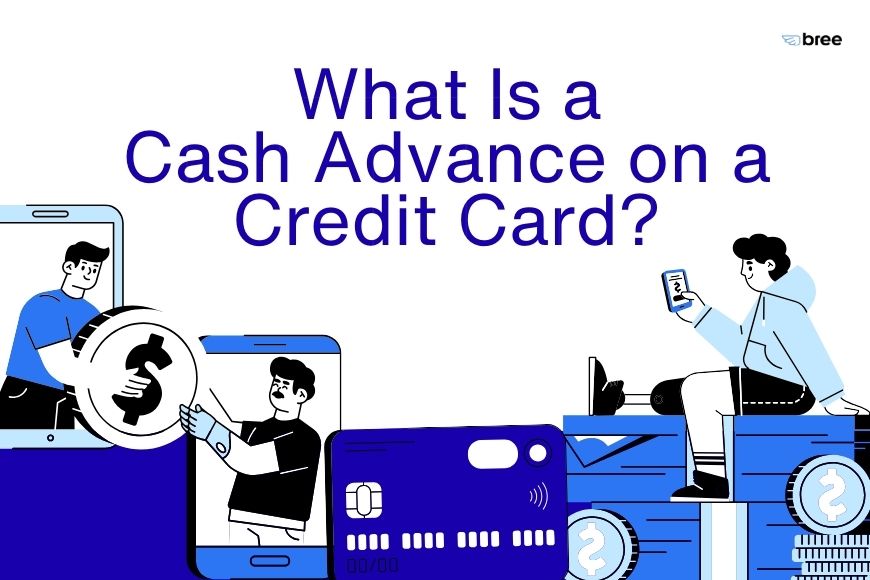When you're strapped for cash and facing an unexpected expense, a credit card cash advance might seem like a quick solution. But before you head to the nearest ATM with your credit card, it's important to understand exactly what you're getting into—and whether there might be better alternatives available to you.
TLDR Quick Summary
- Cash advances = expensive cash from credit cards - You borrow against your credit limit, but pay much more than regular purchases.
- High interest rates - 22.99% to 29.49% in Canada, much higher than regular credit card purchases
- No grace period - Interest starts immediately when you withdraw cash, unlike purchases, where you get time to pay
- Extra fees - $2.50 to $10 per transaction on top of the high interest rates
- Better alternative - Bree offers fee-free, interest-free cash advances for Canadians who need emergency money.

What Is a Credit Card Cash Advance?
A credit card cash advance is essentially a short-term loan that allows you to borrow money against your available credit limit. Think of it as using your credit card to access immediate cash, rather than making a purchase. While this might sound convenient, it's one of the most expensive ways to access cash through your credit card.
Unlike your regular credit card purchases—where you might earn credit card rewards and enjoy a grace period before interest kicks in—cash advances work more like a loan that starts charging you interest immediately. Canadian credit card companies treat cash advances as a separate, higher-risk category of borrowing, which is why they are subject to premium pricing.
Most major Canadian banks, including TD, RBC, BMO, CIBC, and Scotiabank, offer cash advance services, but they typically limit your access to 30-50% of your total credit limit. So if you have a $2,000 credit limit, you might only be able to withdraw $600-$1,000 as a cash advance.
How Does It Work?

Getting a cash advance is relatively straightforward, but the mechanics behind it reveal why these transactions are so expensive. Here's what happens when you take a cash advance:
The Transaction Process:
When you use your credit card at an ATM or request cash from a bank teller, your credit card issuer immediately advances you the requested amount from your available credit. This isn't like a debit card transaction where you're accessing your own money—you're borrowing against your credit line.
Immediate Charges:
The moment your cash advance transaction is processed, two things happen: you're charged a cash advance fee (usually $5-$10 in Canada), and interest begins to accrue immediately. There's no grace period like you get with purchases, so even if you pay off your entire credit card balance the next day, you'll still owe interest on the cash advance.
Credit Limit Impact:
The cash advance amount reduces your available credit immediately. If you had $1,000 available credit and took a $300 cash advance, you'd now have $700 available for purchases (minus the cash advance fee).
If you're tired of dealing with expensive cash advances and their immediate interest charges, Bree offers a better way. With Bree, you can access up to $500 with zero interest and no mandatory fees, helping you avoid the costly cycle of traditional credit card borrowing.
What are the Types of Cash Advance Transactions?
ATM Withdrawals:
The most common type involves using your credit card and PIN to withdraw cash from an ATM. You'll pay both your credit card company's cash advance fee and potentially the ATM operator's fee.
Bank Counter Withdrawals:
Getting cash over the counter at a bank or credit union using your credit card. This usually requires ID and may allow for larger amounts than ATM limits.
Convenience Checks:
These are blank checks that your credit card company might send you, tied to your credit card account. While they appear to be regular checks, any payment made with them is treated as a cash advance.
Cash-Like Transactions:
This category includes buying money orders, travellers' cheques, foreign currency, cryptocurrency, lottery tickets, or casino chips. Even some bill payment services treat certain transactions as cash advances.
Balance Transfers to Bank Accounts:
When you transfer money from your credit card to your chequing or savings account, this typically gets classified as a cash advance rather than a balance transfer.
Online Cash Advances:
Many credit card companies now allow you to request cash advances through their mobile apps or websites, transferring money directly to your bank account.
Cash Advance Fees & Interest
This is where cash advances become particularly expensive, and why many Canadians end up paying far more than they initially expected. The fee structure involves multiple layers that can quickly add up:
Transaction Fees:
Most major Canadian banks charge between $5 and $10 for domestic cash advances. Neo Financial charges $2.50, while banks like TD and BMO typically charge $5 to $10 or a percentage of the advance (whichever is higher). International cash advances cost even more—usually $7.50 to $10, plus foreign transaction fees.
Interest Rates:
Cash advance interest rates in Canada typically range from 22.99% to 29.49%, which is significantly higher than purchase rates, which usually range from 19.99% to 25.99%. TD's Cash Visa, for example, charges 29.49% on cash advances while offering promotional 0% rates on purchases.
No Grace Period:
This is the killer feature that makes cash advances so expensive. While your regular credit card purchases don't accrue interest if you pay your credit card balance in full by the due date, cash advances start charging interest immediately. Even if you pay it back the next day, you'll owe interest for that day.
Compounding Effect:
Cash advance interest on cash advances compounds daily, meaning you pay interest on the interest you have already paid. A $500 cash advance at 24% annual interest rate costs about $0.33 per day in interest charges—but that amount grows if you don't pay it off quickly.
Payment Allocation Problems:
When you make payments on your credit card, Canadian banks typically apply minimum payments to your lowest-interest balances first. This means your high-interest cash advance balance may remain outstanding for longer, accumulating additional interest charges.
Instead of dealing with these expensive fees and interest charges, consider signing up for Bree, where you can access up to $500 with 0% interest and no mandatory fees. It's designed specifically to help Canadians avoid the high costs of traditional cash advances.
What are the Daily Credit Limits?

The cash advance limit works differently from your regular credit card limit, and understanding these restrictions can help you plan better and avoid surprises:
Credit Limit Percentage:
Most Canadian credit card companies limit cash advances to 30-50% of your total credit limit. So, if you have a $3,000 credit limit, you might only be able to access $900-$1,500 as cash advances.
Daily Withdrawal Limits:
Beyond the overall cash advance limit, there are daily ATM withdrawal limits that vary by bank and card type. These typically range from $500 to $1,000 per day for personal credit cards, although premium cards may offer higher limits.
ATM-Specific Limits:
Individual ATMs also have their withdrawal limits, which might be lower than your daily limit. Convenience store ATMs often have transaction limits of $200-$400.
Network Restrictions:
Some ATM networks have different limits from others. Using an ATM outside your bank's network might have lower limits and higher fees.
Available Credit Requirement:
You can only take cash advances up to your available credit. If you've already used $2,000 of your $3,000 limit for purchases and your cash advance limit is 50%, you could only access $ 1,500 in cash advances, not the full $ 3,000.
Reset Timing:
Daily limits typically reset at midnight, but this can vary by financial institution. Some banks reset limits based on a 24-hour rolling period from the date of your last transaction.

How to Get a Cash Advance on a Credit Card
Getting a cash advance is simple, but knowing your options can help you minimize costs:
ATM Method:
Insert your credit card, enter your PIN, select "Cash Advance" or "Credit," and then choose your desired amount. You'll need a PIN set up in advance—contact your credit card company if you don't have one.
Bank Branch:
Visit any bank that accepts your card network (e.g., Visa, Mastercard), present your credit card and ID, and request the amount you need. This method sometimes allows for amounts above ATM limits.
Online/Mobile App:
Many Canadian banks now offer cash advances through their mobile apps or online banking services. The money gets transferred directly to your bank account, usually within 1-3 business days.
Phone Request:
Call the number on the back of your credit card and request a cash advance transfer to your bank account. This method typically takes 2-3 business days.
Convenience Checks:
If your credit card company has sent you convenience checks, you can write them like regular checks, but they'll be processed as cash advances.
Tips to Minimize Costs:
- Use ATMs owned by your bank to avoid operator fees
- Take larger amounts less frequently to minimize per-transaction fees
- Plan repayment immediately to reduce interest charges
- Avoid international cash advances due to additional currency conversion fees
Before going through the hassle of finding the right ATM or dealing with cash advance fees, check out Bree. You can access cash without the complex fee structures or high interest rates that come with credit card cash advances.
What are the Pros and Cons?
Understanding both sides of cash advances helps you make informed decisions about when—if ever—they might make sense:
Pros:
- Immediate Access: Cash advances provide instant liquidity when you need physical cash and can't use a credit card
- No Credit Check: If you already have the credit card, there's no additional credit approval process
- Wide Availability: ATMs and bank branches are widely accessible across Canada
- Emergency Solution: Can help avoid bounced checks or missed payments in true emergencies
- Flexible Amounts: You choose how much to borrow within your limits
Cons:
- Expensive Fees: Transaction fees plus immediate interest make these costly from day one
- High Interest Rates: Premium rates that are typically 2-5% higher than purchase rates
- No Grace Period: Interest starts immediately, unlike regular credit card purchases
- Payment Allocation Issues: Your payments go to lower-interest balances first, keeping cash advances outstanding longer
- Credit Utilization Impact: Reduces available credit and can hurt your credit score if it pushes utilization too high
- Debt Spiral Risk: Easy access can lead to repeated use and growing debt balances
The cons outweigh the pros for most Canadians, which is why alternatives like Bree are gaining popularity. With Bree, you get the immediacy you need without the expensive fee structure.
Better Alternatives to Consider
Before resorting to an expensive credit card cash advance, consider these more affordable options available to Canadians:
Emergency Fund:
The best alternative is having your own emergency savings account. Financial experts recommend saving 3-6 months of expenses, but even $500-$1,000 can cover most cash advance scenarios without any interest or fees.
Line of Credit:
Personal lines of credit typically offer rates around prime + 2-5% (much lower than cash advance rates), though they require separate approval and credit checks.
Personal Loan:
Bank personal loans often have rates between 8-15% for qualified borrowers—significantly cheaper than cash advances, though approval takes longer.
Bree Cash Advances:
Bree offers Canadians up to $500 in cash advances with 0% interest and no mandatory fees. Unlike credit card cash advances, Bree doesn't charge interest, doesn't require credit checks, and provides budgeting tools to help you avoid future cash crunches.
KOHO Overdraft Protection:
KOHO offers up to $250 in overdraft protection with no interest charges, provided you have a KOHO account.
Family and Friends:
Borrowing from family or friends can provide interest-free loans, although it's essential to formalize agreements to protect the relationship.
Employer Advances:
Some employers offer payroll advances that let you access earned wages before payday, often with minimal or no fees.
Bank Overdraft:
While expensive, bank overdraft fees might be cheaper than cash advance fees for small, short-term needs.
Sell Items or Take on Gig Work:
Consider selling your unused items online or taking on short-term work through apps like Uber, DoorDash, or TaskRabbit.
When Do Cash Advances Make Sense?

While we generally recommend avoiding cash advances due to their high cost, there are very limited situations where they might be the least bad option:
True Emergencies Only:
Consider cash advances only for genuine emergencies where you need cash immediately and have exhausted all other options. Think medical emergencies, urgent car repairs needed for work, or preventing utility disconnection.
Very Short-Term Needs:
If you can repay the advance within a few days and the total cost (fees plus interest) is less than the cost of the alternative (such as bounced check fees), a cash advance may make sense.
No Other Credit Available:
If you don't qualify for personal loans, lines of credit, or other lower-cost options, and the cash need is urgent, a cash advance might be your only choice.
Avoiding Higher Penalties:
Sometimes the cost of a cash advance might be less than late payment fees, NSF charges, or other penalties you'd face without the cash.
Small Amounts, Quick Repayment:
For very small amounts that you can pay back quickly, the total cost might be manageable, though fees make small cash advances particularly expensive on a percentage basis.
What Doesn't Qualify:
- Regular monthly expenses
- Non-urgent purchases
- Paying other credit cards or loans
- Entertainment or discretionary spending
- Taking advantage of sales or deals
Even in emergencies, it's worth exploring Bree as an alternative. With instant funding options and no interest charges, Bree can provide the emergency cash you need without the expensive consequences of traditional cash advances.
Tips for Responsible Use
If you find yourself in a situation where a cash advance is unavoidable, here's how to minimize the damage:
Before Taking the Advance:
- Calculate the total cost, including fees and estimated interest
- Have a specific repayment plan before you withdraw money
- Consider if you can wait a few days for a cheaper alternative
- Check if your employer offers payroll advances
- See if family or friends can help
Minimizing Costs:
- Use your own bank's ATMs to avoid operator fees
- Take only what you need
- Choose the lowest-fee method available (sometimes online transfers are cheaper than ATM withdrawals)
- Avoid international cash advances due to currency conversion fees
Repayment Strategy:
- Pay it back as quickly as possible—every day counts
- Make payments directly toward the cash advance balance if possible
- Consider making multiple small payments to reduce daily interest charges
- Don't just pay the minimum monthly payment if you have cash advance balances
Avoiding Future Cash Advances:
- Build an emergency fund, even if it starts at $50-$100
- Set up overdraft protection on your bank account
- Consider a line of credit for emergency access
- Use budgeting apps to track your cash flow better
- Look into Bree's budgeting tools to help prevent future cash crunches
Also read: Best Cash App Alternatives in Canada
FAQs
Does a cash advance hurt your credit?
Cash advances don't directly hurt your credit score, but they can indirectly impact it in several ways. The cash advance itself doesn't show up separately on your credit card statement—it just appears as part of your overall credit card balance. However, cash advances can hurt your credit if they:
- Increase your credit utilization ratio (balance relative to your credit limit)
- Lead to missed payments due to high interest charges
- Push you over your credit limit
- Result in carrying high balances for extended periods
What is the penalty for a cash advance on a credit card?
There isn't a specific "penalty" for taking a cash advance, but the costs are substantial:
- Transaction fees: $5-$10 per domestic transaction, $7.50-$10 for international
- Higher interest rates: Typically 22.99%-29.49% vs 19.99%-25.99% for purchases
- Immediate interest charges: No grace period, so interest starts day one
- Daily compounding: Interest compounds daily, increasing the total cost
If you miss payments while carrying a cash advance balance, you may face penalty interest rates of 27.99% to 28.99%, making an already expensive situation even worse.
Is it a good idea to take a cash advance on your credit card?
Generally, no. Cash advances are among the most expensive forms of consumer credit available to Canadians. The combination of transaction fees, high interest rates, and immediate interest accrual makes them costly even for short-term use.
For most situations, alternatives like Bree offer significantly better terms, including 0% interest and no mandatory fees.
Is paying bills with a credit card a cash advance?
It depends on the method and the biller. Most regular online bill payments through your credit card are treated as regular purchases, not cash advances. However, some transactions might be classified as cash advances:
- Using convenience checks to pay bills
- Making payments through certain third-party payment services
- Paying taxes through some government portals
- Money transfers to pay bills
- Some utility or rent payments through cash advance features
Key Takeaways
Credit card cash advances in Canada are expensive, convenient loans that should be avoided except in true emergencies. With transaction fees, high interest rates starting at 22.99% and 29.49%, and immediate interest charges with no grace period, they're among the costliest ways to access cash.
Instead of dealing with expensive cash advance fees and immediate interest charges, consider Bree for your emergency cash needs. With up to $500 available at 0% interest and no mandatory fees, Bree provides the financial flexibility you need without the costly consequences of traditional credit card borrowing.

Citations:
[1] https://www.scotiabank.com/ca/en/personal/advice-plus/features/posts.what-is-a-cash-advance.html
[2] https://www.canada.ca/en/financial-consumer-agency/services/banking/atm-fees.html
[3] https://support.neofinancial.com/hc/en-ca/articles/18195645001101-Cash-advances-on-your-credit-card
[4] https://rates.ca/resources/truth-about-credit-card-convenience-cheques
[5] https://wowa.ca/cash-advance-credit-card
[6] https://www.td.com/content/dam/tdb/document/pdf/personal-banking/tdcash-personal-terms-en.pdf
[7] https://www.scotiabank.com/ca/en/personal/credit-cards/fees.html
[8] https://www.rbcroyalbank.com/cards/cardapp/_assets-custom/pdf/cashback_mc_1.9_for_10.pdf
Join our newsletter to get the latest updates






